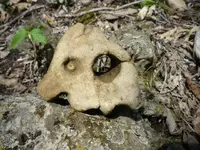Looks like limestone altered by several processes of erosion. The irregular shapes can be caused by both mechanical and chemical erosion.
Examples of Chemical Erosion:
1. Carbonation - When carbon dioxide is present and carried by water, carbonation weathering can occur. The carbon dioxide reacts with the water, which forms a weak acid and eats away at the affected rock.
2. Hydration - This type of weathering occurs when rocks absorb water, and the resulting hydrogen and hydrate ions form new bonds with minerals present within the rock. This type of chemical erosion can actually result in a change to a new form of rock, such as the process by which gypsum is formed.
3. Hydrolysis - This erosion takes place when minerals in the rock form a new solution, usually due to the presence of water. An example of this would be the formation of salt water when natural minerals in the rock form a salt solution once water is introduced.
4. Oxidation - Much like carbonation-which occurs in the presence of carbon dioxide-oxidation takes place when rocks react with the presence of oxygen. Oxidation also requires the presence of water, but this can even be in such small amounts as the presence of moisture in the air. Oxidation is more commonly known as rust.




